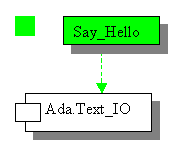[ Table of Contents ] [ Chapter Overview ] [ Next ] [ Glossary/Index ]

|
This diagram represents the architecture of our first example. The code is
shown below. There are two Ada modules involved, a procedure
named Say_Hello and a package
named Ada.Text_IO. The latter is provided to
us as part of Ada’s predefined
environment. The dashed arrow represents a dependency relationship
between the procedure and the package. That is, the procedure depends upon resources
exported by the package. The other symbols are discussed in Chapter 2. |
You can click on green elements of the diagram to jump to corresponding elements of
code. Clicking on the green square in the upper left corner takes you to a point just
above the code listing.
Source Code Listing
---------------------------------------------------------------
-- This program prints out the word "Hello"
---------------------------------------------------------------
with Ada.Text_IO; -- context clause
procedure Say_Hello is -- procedure body starts here
begin
Ada.Text_IO.Put_Line("Hello"); -- procedure call
end Say_Hello; -- procedure body ends here
---------------------------------------------------------------
|
Comments
Note that a double-dash (--) marks the beginning of a comment
(text ignored by the Ada compiler). Each comment ends with the end of that line of text.
Context Clauses
The first line of code is called a context
clause, specifically a with clause.
It establishes the dependency relationship mentioned above. The procedure Say_Hello
"withs in" (depends upon) the package Ada.Text_IO.
Executable Code
There is only one line of executable code in this example, the procedure call to the Put_Line procedure exported by the Ada.Text_IO
package (pronounced "Ada-dot-Text-I-O").
Every sequence of executable lines of code is bracketed between the words begin
and end.
Reserved Words
Note also that five words in the example are shown in bold font. These are some of
Ada’s reserved words. Ada has 69
reserved words, which are listed in Appendix A. We will continue to follow this
convention, showing reserved words as bold, and in lower case, in all Ada code listings.
Names: Rules and Style
The names (identifiers) of elements
(such as the name Say_Hello) consist of letters of the alphabet (upper or lower case),
decimal digits and underscores, with no spaces. The first character must be a letter.
Underscores may occur only one at a time, neither first nor last. Ada is not case
sensitive. It is conventional practice for many Ada programmers to use the style
illustrated here, using upper case for the first character of each word in an identifier
and lower case elsewhere.
Related Topics
[ Back to top of page ] [ Next ]
